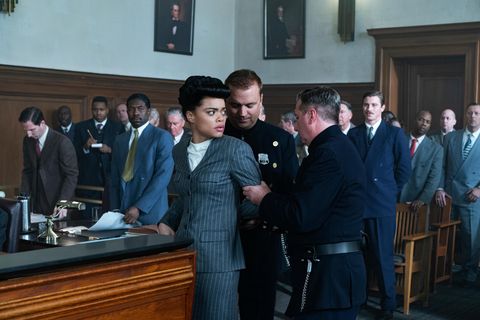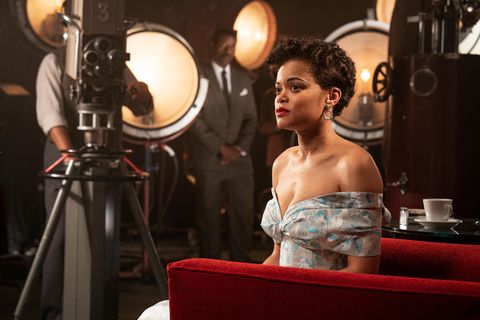With her mesmerizing voice and powerful performance style, Billie Holiday’s enduring legacy stretches beyond her impact on jazz and popular music. Her song “Strange Fruit,” based on a poem metaphorically describing a lynching, became a protest anthem in the years leading into the civil rights movement. But Holiday also battled substance addiction while dealing with a lifetime of abuse, and J. Edgar Hoover’s FBI used this to relentlessly pursue and persecute her—as exemplified by the title of a new biopic about her life, The United States v. Billie Holiday.
Directed by Lee Daniels, the movie portrays the legendary singer (Andra Day) at the pinnacle of her career, which was captured through famous black-and-white photos from the ‘40s and ‘50s. Costume designer Paolo Nieddu eagerly took on the challenge of reimagining renowned moments of Holiday—like a famous image of the singer entranced mid-song with her signature gardenia clipped above one ear—for the biographical drama.
The movie boasts high style behind-the-scenes; thanks to the director’s connections, Prada not only opened up the contemporary archives for the film, but also collaborated with Nieddu to reinterpret nine of Holiday’s most recognizable looks. After scouring over 40 seasons of runway collections, Nieddu pinpointed Holiday-referential elements and worked with in-house artisans to design one-of-a-kind pieces. “It was literally custom Prada,” Nieddu says over the phone.
Below, Nieddu talks through mixing history with 21st-century runway styles and discusses his own bespoke showstoppers, one of which involved expertise from Old Hollywood dressmaker and Orry-Kelly tailor John Hayles. “It was like Billie’s spirit was alive,” Nieddu says.
Lady Day in Red at the Café Society
Holiday first performed “Strange Fruit” in 1939 at the Café Society, or “the wrong kind of place for the right kind of people,” as described in the movie. For a 1947-set scene at the integrated Village hotspot, Billie, in a light-catching crimson gown, sings to a rapt audience, including Tallulah Bankhead (Natasha Lyonne). Referencing mostly black and white photos, Nieddu enjoyed creative freedom to play with color, especially based on the script and directorial vision. “I knew Lee wanted a red dress moment,” Nieddu says.
Inspired by a shimmering lapel-halter style dress Holiday wore onstage at the Free Trade Hall in Manchester, England in 1954, Nieddu looked to a strapless confection from the Prada Fall/Winter 2004 runway for the molded bodice and bust. He then incorporated the halter straps and luminous lamé fabric, but in red, from a Spring/Summer ‘09 dress and elongated the skirting to floor-length. “It was sort of this Frankenstein process,” Nieddu laughs.
Classic Black and White
With Louis Armstrong (Kevin Hanchard) playing trumpet and Fed Harry Ansligner (Gareth Hedlund) lurking in the audience, Day stuns in a reinterpretation of one of Holiday’s most recognizable stage moments. In 1947 at the famed Downbeat Club, jazz photographer William P. Gottlieb snapped Holiday in a black and white broderie anglaise gown with an oversize bow at the bustline. “I felt like that would be such a cool image to bring to life,” says Nieddu.
Nieddu precisely—and ingeniously—detected a throughline to the original bodice from a car racing uniform-reminiscent of a Spring/Summer 2012 maillot in a totally different fabrication. “It was wild how things paralleled so well,” he says. Nieddu then worked with Prada to translate the patterns and lines onto black taffeta and white 3D floral embroidery, lower the bow to the waistline, and drop the hemline to the floor.
Courtroom Pinstripes
Day appears in court in a near-replica of Holiday’s photographed pinstripe skirt suit, but with another present-day high-fashion component. Nieddu based his custom design off a vintage suit jacket and separate skirt from Western Costume Co. “I sketched out the strong shoulder peak lapel coat to be on her shoulders when she arrived,” he says. But instead of guessing a color, he worked off the historic black-and-white photograph as is. “The gray seemed fitting. It was a very muted moment,” he explains. But finding “the perfect shade of gray” proved a challenge—until he landed on a cashmere chalk-striped wool and silk crepe from Loro Piana.
The Comeback Gown
After an early release from prison in 1948, Holiday made her triumphant return to a sold-out crowd at Carnegie Hall. For a dramatization of the powerful event, Nieddu not only looked to “grainy” historical photos but also musical lore. While pinning a fresh gardenia into her hair before the show, Holiday reportedly cut her finger. “So she switched to a black dress because the blood wouldn’t show,” says Nieddu.
For Day’s Billie, Nieddu originally designed a dress with floral and ruffle detail, but after a fitting, decided “it wasn’t wowing enough.” Nieddu then sketched out an entirely new black silk gown during a flight from Montreal to Los Angeles. He added a “drama shoulder” and extra movement with sheer silk chiffon panels down the front and the sides. “So that a little light would come through it and then you would really see her body,” Nieddu says. “She almost appears like a statue.”
While costume-designing the pilot of Eva Longoria’s 2015 show Telenovela, Nieddu met Hayles, who was then still head tailor at Universal Studios. While working on The United States v. Billie Holiday a few years later, Nieddu convinced the now-retired dressmaker, who designed for Marilyn Monroe, to make a few of Billie’s elaborate gowns in his home workshop. “He loves dressmaking, particularly, and he understood the era, the right fabrics, and the right shoulder pads,” says Nieddu. “He is incredible.”
Yellow Splendour
Holiday’s conviction caused her to lose her cabaret card as part of New York City’s Cabaret Laws (some still exist to this day), which were yet another way for the government to silence Black voices and, in cases like Holiday’s, risk their livelihoods. Though she no longer had a license to perform at venues serving alcohol, in the film, Billie finds an illicit residency at Club Ebony, and first wanders into the lively space in a sublime yellow gown with stunning crystal work.
Nieddu took inspiration from Holiday in a puff-shoulder and sequin-embroidered dress from a September 1946 issue of Look magazine. He transformed the draped shoulders from a Fall/Winter 2017 last look into a long-sleeve, v-neck bodice and looked to Resort 2011 for the languid skirting. Nieddu then worked with fellow costume designer and artist Maria Hooper to sketch a crystal-work pattern for the Prada artisans to embellish onto marigold silk satin. Broadway’s go-to silk flower purveyor, Dulkin & Derrick, provided the blooming white gardenia for Day’s hair, while Nieddu completed the look with a pair of vintage earrings out of his “bag of tricks.”
A Hit-Making Top and Trousers
Without her cabaret card, Billie goes on tour with her band to perform in theaters and concert halls. For a particularly rousing performance in 1949 Baltimore, she brings down the house in a fully beaded red flutter-sleeve crop top and matching wide leg pants. Nieddu custom-designed the outfit based on a vintage ‘30s top, but the trouser inspiration came from Day. “Andra was like, ‘I want to be able to get down towards the audience and move,’” says Nieddu. “So this worked out perfectly for that scene. It was this playful costume in a very playful fun scene.”
Throwback Florals
Along with custom-designing and reimagining contemporary runway looks, Nieddu sprinkled in gorgeous vintage. “I would dip back into the ‘30s because, if you were in 1947, you would still have clothes from 1937 in your closet,” explains Nieddu. Billie’s vivid yellow dress harmonizes with the sunlit summer day, especially as she runs through greenery and tall grass. The vibrant floral embroidery and long colorful fringe, which emphasize her frantic movements, juxtapose against a particularly harrowing scene. “We needed something to be easy for the action and could be believable that she would be on the tour bus and still looked glamorous,” says Nieddu. “She still looks like the star on her Billie Holiday orchestra bus.”
Off-the-Shoulder Brocade
In another moment of fashion kismet, Nieddu paid homage to Holiday’s off-the-shoulder floral dress for a Valentine’s Day performance in 1954. He referenced a Fall/Winter 2019 look for the pleating and twist on the bodice and a ‘50s-inspired knee-length look from Fall/Winter 2013 for the flared silhouette. But a “silvery blue satin floral” brocade from Spring/Summer 2018 is an absolute jaw-dropper in likeness to Holiday’s actual dress. “It’s nearly identical,” marvels Nieddu. The name of her penultimate 1958 album also feels like cosmic coincidence. “Lady in Satin is like a Billie Holiday trademark,” he adds. “There is nothing like Prada satin in any fashion brand.”
The “Quintessential” Billie Holiday Gown
Holiday’s most iconic look almost didn’t make it into the film. For her last major jazz concert, at Town Hall in 1958, she wore a strapless white gown with contrast pleating and crystal embroidery on the bodice. For the film’s version, Nieddu looked to the body-hugging silhouette and plunging sweetheart neckline from a Spring/Summer 2014 dress. He then worked with Prada’s dressmakers to bring the hemline to the floor, add a train and embellish the entire gown with geometric beading and crystal-work. Then…the scene was cut.
Daniels almost incorporating it into a ‘40s-set sequence, but the image of Holiday in a similar dress remains tied to 1958—and the last years of her life. “Her fans will know,” says Nieddu. Then a fantasy montage sequence, as Billie sings “Strange Fruit,” offered the most impactful opportunity. “It’s an era that isn’t tied to anything historically documented, but it’s Billie’s essence, and it’s Billie’s image and her style,” says Nieddu. “It’s quintessential Billie, so it worked perfectly there.”
Watch The United States v. Billie Holiday on Hulu
This content is created and maintained by a third party, and imported onto this page to help users provide their email addresses. You may be able to find more information about this and similar content at piano.io










